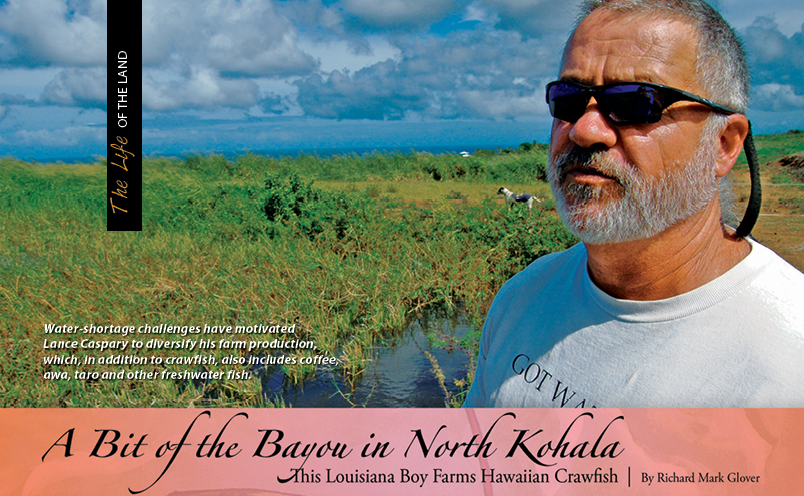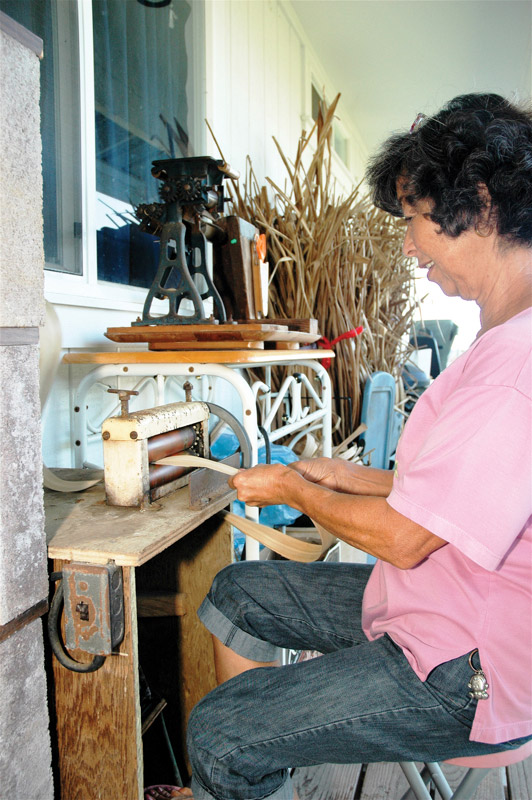
A Bit of the Bayou in North Kohala: This Louisiana Boy Farms Hawaiian Crawfish
By Richard Mark Glover
Barefooted, Lance Caspary wades into the rice pond and lifts a triangular trap out of the water. As white caps curl below in the sea along the rugged North Kohala coastline, the sun sparkles from Lance’s teeth when he smiles. He winks, then says, “Tell me they wouldn’t like these in New Orleans.”
Bright crimson crawfish (‘opae pake) scramble out of his grasp. Some drop, splashing back into the pond. Others swivel bony pinchers to examine human hands.
“Produced 45,000 pounds in 2005, but the earthquake put an end to that run,” he says.
Louisiana-born Caspary started raising crawfish on the Big Island in 2002. Backed with plenty of low-cost water to make the perfect environment for his freshwater crustaceans on the Kohala Crawfish Farm, things were looking good—at one time he shipped 250 pounds a week to a single restaurant on O‘ahu.
Then the Kiholo quake of ‘06 struck. The 6.7 magnitude epicenter nucleated less than 30 miles from his farm.
“Things shook,” he says.
The worst part for Caspary and other farmers in the area was the damage to the Kohala Ditch. With busted tunnels and cracked flumes, ditch owners Surety Kohala Corp., a land-owning corporate vestige from the sugar cane industry that dominated agriculture in Kohala for decades, could no longer supply water from the lush Honokane Valley, 20 miles to the east. Farmers began pumping from a Hawi well and thanks to Uncle Sam, the nearly 1,000 gallons of diesel needed daily to fuel the pumps was covered by the Civil Defense budget.
But not all the farmers were on the well pipeline.
“I’m high and dry—still,” he says, standing under a giant monkey pod tree near his barn. “For most people the quake is a distant memory, but I’m still in survival mode.”
Under a gentleman’s arrangement with Hawi Agriculture and Energy, Caspary recently “cowboyed in” two new crawfish ponds near Hawi, where, for the moment, water flows. A third pond, according to Caspary, has been on hold for 13 months as federal and state regulators debate new pond construction requirements.
The trades gust and the rice plants shimmy. Caspary slips his hand into the water and pulls up a green shoot.
“Rice is forage for crawfish. It offers a vertical substrate in the water column, like a reef,” he says, as a flock of cowbirds and a pair of Koloa Maoli (Hawaiian duck) fly overhead. “Birds eat the rice and I harvest the crawfish.”
Caspary also raises Malaysian freshwater prawns on a limited basis. “I nurse them through the larvae stage, the most critical part, and then sell them,” he says, standing between columns of aquarium tanks near his house. “If it’s done right, they can reach nearly a pound in six months.”
He planted 500 coffee plants four years ago to help his bottom line. Walking down the rows, he points out the ripe cherries, brilliant red against the green-leafed stalks, then spies a nearly endless series of dark, shriveled clusters.
“Drought,” he says. He grinds the seed cluster in his hands. “If it’s not one thing it’s the other—but that’s the life. I’m not complaining. Before farming, I dreaded work, but in spite of it all, I look forward to this every day. The money’s not the same, but it’s more rewarding.”
Inside Caspary’s solar-powered home, rounded walls, a table made from koa, guitars, violins and a wooden bench press tell of his talents. “I was a carpenter, built a lot of houses on this island before I injured my back. I was rehabbing in the weight room when this fellow tells me about land up in Kohala. That was ’92,” he says.
Caspary has grown a number of crops on the 20 acres including awa, ti and taro. “Something spiritual about growing taro,” he says, his green eyes blinking. He pauses. “All farming really—there’s something incredibly right about having your life and livelihood tied to the land.”
Hawai‘i’s only crawfish farmer looks out across the green fields of Kohala. “The taro farmers down in Waipio Valley were real sweet to me, especially when I told them I was here to trap crawfish,“ Caspary said. “That’s where I got my original stock.”
To some, crawfish are a nuisance. In Japan they are considered bad luck and the Japanese word for crawfish translates as “cockroach of the river.” Crawfish are known to eat taro and sometimes rice and at one time were on Hawai‘i’s prohibited species list. But in many places like Sweden, they are considered a delicacy and boiled with dill. France is also fond of “ecrevisse,” and in Spain, over 100,000 hectares of “cangrejos de rio” are farmed for the sweet, lobster-like meat. Louisiana continues to be the top producer of live crawfish, while China is now farming mud bug, exporting frozen tail for the crawfish bisque, pie and e’touffee markets on the mainland.
Hawai‘i’s palate, shaped by the bounty of the islands, has never feared the exotic.
“The Kohala crawfish are a great addition to our other shellfish,” said Morgan Brunnell, chef of the Blue Dragon, a restaurant specializing in global coastal cuisine in Kawaihae. “And most of it’s locally produced. We buy as much as we can from Lance and serve the crawfish as pupu boiled in Zatarain’s with a side of butter sauce, Tabasco and garlic.”
Caspary has also raised grass carp and milk fish for food and a variety of freshwater tropical fish.
“After the back injury I had to reinvent myself,” Caspary said. “Most of my schemes were commodity manipulations for personal gain, but after involvement with the intricate web of life on the land, the important Hawaiian concepts of ‘kuleana’ and ‘malama ‘aina’ dawned on me quite naturally.”
The Kohala Food Forum, a grassroots organization in Hawi, has set a goal for the district to eventually grow 50 percent of its own food.
“It’s a great idea,” Caspary says. “I mean, what happens if the barges stop—what happens if they go on strike?”
Hawai‘i Island is served by two inter-island barge lines: Matson Navigation and Young Brothers, which shuttles cargo from Honolulu, the only Hawaiian port served by trans-Pacific carriers. And according to AlternativeHawaii.com, 90 percent of the islands’ food is imported, while the Big Island itself has less than a seven-day supply of food in stock.
“It would take 3,500 acres to feed half of Kohala’s population,” Caspary says, “and I doubt we have 5 percent of that in cultivation now, but it’s something to shoot for.”
A trade cloud opens and sprinkles as silent circles form on the surface of the pond. “We need more of that,” Caspary says, shielding his eyes against the half-sun sky. He checks the three-inch pipe gurgling water into his pond. “I’m going to over-flood it,” he says. “Who knows when they’ll turn it off again.” He nods at the stacked sets of new pipe and a front-end loader marshaled at the top of the hill.
In dry conditions, crawfish dig tunnels into the mud and burrow. “I’m told the crawfish in Australia go into a semi-dormant state and can live five years inside their tunnels,” Caspary says. “They don’t last that long here, but fortunately they do mate in the burrows and whole families emerge if the water comes back in time.”
Water and affordable land continue to be a challenge for agriculture in Kohala. Their north island neighbors to the east, Hamakua District, have secured federal and state funds to repair the earthquake damage to Hamakua Ditch, which is owned by Kamehameha Schools and leased to the State of Hawai‘i. Agricultural land leases through the Hamakua North Hilo Agriculture Cooperative are also available to small and large farming enterprises.
The privately owned Kohala Ditch has made many repairs since the earthquake but is not yet at its pre-quake capacity. According to the North Kohala Community Resource Center website, a new non-profit entity is being formed to take over the maintenance and operation of the ditch.
“In a way, the earthquake was good,” Caspary says. “It forced people of Kohala to come to the table and ask: ‘Do we want farming here?’”
Photos by Richard Mark Glover



